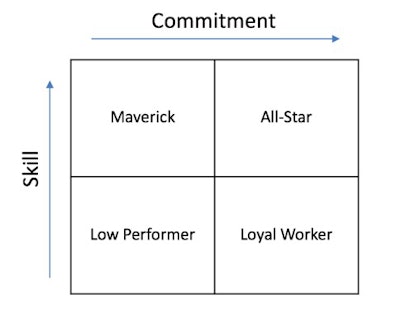
This is why the “mid-summer-stutter” presents such a danger to our production season. What is the “mid-summer-stutter” you ask? Well, it’s the name I’ve started to use for the nose-dive in productivity that seems to plague our teams in late June and July. You know the one I’m talking about. Feet start to drag, voices start to grumble, jobs drag on, quality slips, and the landscaping machine of a business you’ve spent the last six months building shows its first sign of weakness.
You and your team are far enough away from the start of the year to feel tired, but not close enough to the finish to see the light at the end of the tunnel, and we find ourselves stuck in a lethargic, heat-induced daze. Right when producing jobs on time and on-budget matters most, our guys and girls stop doing exactly that. And as hot as it is, the snow will be here before we know it. We need to pick the pace back up, and we need to do it fast. So, where do we start?
Identify the performance gap
If someone is underperforming, he/she is usually missing one of two things: skill or commitment. Have a look at this diagram and ask yourself: Who is on my team?
- All-Star: Always on time, has a positively killer attitude, gets things done, customers love him/her.
- Maverick: Mavericks are talented and capable. They can work circles around most of their teammates but their poor attitude and lack of ‘buy-in’ can cause friction and keeps them from being the true all-star they have the potential of being.
- Loyal Worker: You love this guy/girl. He/she is a team player, looks up to you as a leader, customers and crew members alike love him/her for his/her temperament. He/she cares about the business and your clients. But the problem is, he/she is slow, and the quality of work could use an upgrade. It would be crazy to get rid of a team player like him/her, but if you’re honest with yourself, his/her performance needs to improve.
- Low Performer: Not only is he/she a lousy landscaper but his/her attitude is in the gutter, too. You find yourself wondering, “Why did I hire this guy/girl?”

On the other end of the scale, Low Performers are simply too far away from where they need to be to justify pouring your finite resources into them in an attempt to develop them. Chalk it up to a bad hire, let them go as soon as it’s reasonable to do so and move on.
The Maverick and the Loyal Worker – these guys you can work with. Go back to the chart for a second and let it sink in. What is it telling us? The Maverick is lacking commitment, working on his/her skills would be a waste of time because at this point, he/she is probably a better landscaper than you are. What’s missing for him/her is simply ‘buy-in’ – he/she needs to care more about the company and his/her role in it.
The Loyal Worker is already trying his/her best; he/she just needs to be skilled up. He/she needs coaching, mentorship and specific feedback on where he/she can improve his/her jobsite performance.
Skilling up: Improving the performance of ‘Loyal Workers’
Staff productivity depends, to a large extent, on your employee’s competence. But what is competence? Think of it as two parts you can influence:
- Knowledge – I have learned how to do something.
- Ability – I have practiced something and got good at it.
So, how do you give people the knowledge and ability they need to be productive? Well, you start by giving them a tool that outlines how to do something and then gives a consistent, step-by-step method for practicing that skill in a way that the employee can gain experience and gather feedback on his/her performance. This is called a competency model, which is a framework for defining the tasks, skills and knowledge necessary for successful performance in a specific role.
The purpose of the competency model is to give the Loyal Worker the straightforward, concise instruction an employee needs, and to empower him/her with a clear method of practice so he/she can gain feedback and further his/her ability along the way. What’s the outcome? More productive staff.
If you don’t have one of these, don’t worry. You can use the competency model I’ve built and I’ll even give you a fill in the blanks template for you to customize for own company! Just click here and use TLCSTAFF19 as your download code.
With a complete competency model in hand, go spend an hour a day for a week with your Loyal Workers. Grade their performance against the checklist, and you’ll quickly start to see where these guys need to be coached.
The power in observing performance with a competency model in hand is that you are able to give extremely specific feedback. I promise you, there are a couple of very obvious things your Loyal Workers are doing incorrectly that, once addressed, will bring their speed and quality up substantially! Plus, they will appreciate the time spent with them more than you can imagine.
Increasing commitment: Improving the performance of ‘Mavericks’
Mavericks are tricky. They’re good at what they do, and, unfortunately, they know it.
They ride this talent and see it as more than compensating for their less-than-desirable commitment. For most Mavericks, the first step in increasing commitment requires you to actually have some healthy conflict. You need to have a very real conversation with them. Scary, I know, but oh so necessary if you want to turn this guy or girl around.
There is likely something left unresolved, something they aren’t telling you. He’s mad at you because his crew isn’t as fast as he is and its holding him back. She’s frustrated because she feels she is entitled to more compensation. I don’t know exactly what it is, and neither do you. That’s the problem.
Offer to buy your Maverick lunch or dinner and go somewhere nice. It’s important not to have this conflict conversation anywhere near work. A gesture like this makes your Maverick feel valued, and being away from anything business-related will make him/her feel a lot safer and open to being totally honest with you.
Ask them how they’ve been doing: What’s going well? What are you struggling with? Are you frustrated with anything? Get them talking, and then shut up and listen. Once they’ve got it all out, acknowledge their challenges and make them feel understood. Now it’s your turn to calmly and assertively let them know they are underperforming. Tell them how much potential you see in them, that you want to see it fulfilled, and that you want to discuss ways of problem solving whatever might get in the way.
For the Maverick, motivation comes from knowing what is important and understanding why it’s important. I like to assume employees want to do good work, but they need to know what “good work” is. And the hard truth is that employers often don’t communicate this.
The whole point of an employment agreement is to clearly communicate why the role is important, why the employee should care about it, how to do it and what needs to be done. Now would be a great time for the two of you to re-read his/her employment agreement so he/she knows, in no uncertain terms, what the job entails.
If you, like most landscapers, don’t have employment agreements for your staff, I’ve got your back. I’ll share with you a completed one, as well as a fill-in-the-blank template so you can quickly make your own. Click here and use TLCSTAFF19 as your download code to request these documents.
Keep it simple, guys! Your Loyal Workers legitimately need skill development, and as their leader, that’s on you. Your Mavericks need some conflict resolution and little realignment. Get that competency model built, review some employment agreements and go coach your team like the epic entrepreneur that you are. There is still a whole lot of season yet, so go make the most of it!
EDITOR’S NOTE: This article was written by Benji Carlson, assessment specialist with Breakthrough Academy.











